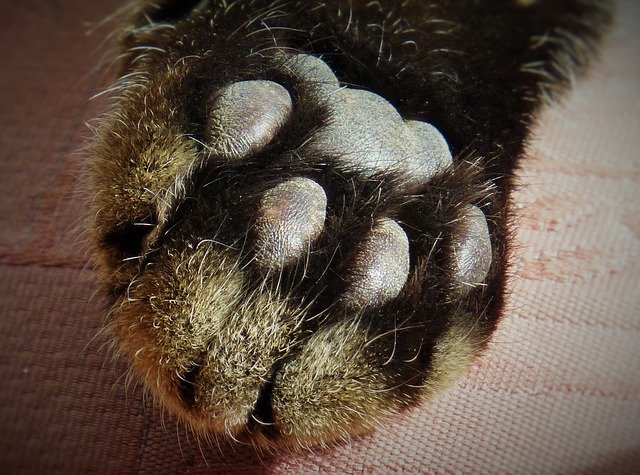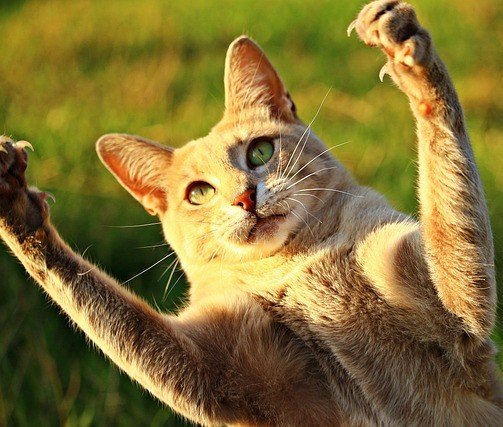Cat Paws: 11 Fun Facts About Your Kitty's Tootsies
Kitties are unique in so many ways, from their perky ears (which have 32 muscles compared to our measly six) to their complex cat paws. Those cute little toe beans do much more than help your kitty stand. Cat paws are essential for helping your kitty run, play, hunt, stay healthy, and even communicate with other cats.
Check out our list of 11 amazing facts about cat paws.
1. Your cat’s thick paw pads serve as shock and sound absorbers.
Indoor cats may have soft, velvety paw pads, but that same skin is extremely tough and capable of incredible things. Not only does it protect your cat’s paws from rough terrain, but it also helps cushion the blow during physical activity. Our kitties can jump up to six times their own height. In addition to positioning their bodies to brace for impact, their tough paw pads act as shock absorbers to prevent injury. They also play a role in allowing them to silently sneak up on prey (more on that later).
2. Most cats have 18 toes, but some have many more.
The average cat paw is designed like a dog’s with four toes and one dewclaw on the front and four toes on the back for a total of 18 toes. However, some cats have a genetic abnormality that causes them to have several more toes, complete with additional claws. The condition is known as polydactyly, and cats that have it are born with six or more toes on each paw.
Polydactyl cats are perfectly normal and healthy in every way, except for their additional toes, which require frequent trims to prevent injury.
A polydactyl ginger tabby named Jake holds the Guinness World Record for the most toes with seven toes on each paw for a total of 28!
3. Cats can retract their claws.
Unlike dogs, cats can relax the tendons in their toes to retract their claws while walking. This, in addition to their thick paw pads, allows them to creep up silently on their prey. When they are ready to attack - or scratch an itch - they flex their tendons, pushing their sharp claws forward and ready for action. Your cat's retractable claws also help them climb and gain traction on slippery surfaces.
4. Cats are digitigrade walkers.
When you walk, your weight is supported by the balls and heels of your feet. Cat paws are different. They bear the cat’s weight on the balls and tips of their toes. This is called digitigrade walking, and it allows them to walk more delicately and quietly (as long as their claws are retracted, of course).
5. Your cat’s paws help them mark their territory.
You’ve heard of cats spraying to mark their territory, but that’s not the only method they use. Cat paws are equipped with specialized glands that secrete a unique scent when they scratch something. This is one reason cats often claw at vertical surfaces. It helps to sharpen their claws, but it also marks these areas with a message for other cats. For example: “This tree is mine!”
6. Cat paws help perceive and regulate temperature.
Your cat’s paw pads help them sense the temperature of their environment and quickly determine the difference between hot and cold surfaces. These same temperature sensors even help cats evaluate their prey.
Cats also have sweat glands in their paws that help them regulate their own body temperature. These same glands release sweat when your kitty is feeling anxious or stressed. This is why many cats leave sweaty paw prints on the examination table when visiting the vet.
7. The skin on cat paws is as unique as a human fingerprint.
Did you know that cat paws are equipped with tiny grooves that are unique to each individual kitty? Similar to a human fingerprint, your cat’s little toe pads can even be registered to unlock an iPhone!
8. Cat paw color often matches cat coat color.
Solid-colored cats have solid-colored skin, while cats with multi-colored coats have spots of color on their skin. This rule extends to their paw pads, which are typically the same color as their coat. Tabby cats and those with stripes can have multi-colored paw pads ranging from pink to black.
9. Cats knead their paws when they are happy or in need of comfort.
A purring, kneading cat is usually a happy cat. However, kneading can also be a coping mechanism. When lonely, stressed, or ill, your cat may use their paws to create a calming, self-soothing mood through kneading.
10. Each individual joint in a cat’s paw can develop joint disease.
Cat paws are dainty and made up of several tiny bones, articulated joints, and soft tissues such as muscles, ligaments, and tendons. Just like humans who develop arthritis in their ankles, wrists, toes, and fingers, cats can suffer from joint disease in every digit and moving part of their paws. If it can be flexed, it can be afflicted with osteoarthritis. This is why it is important to monitor your kitty for signs of pain, especially as they get older.
11. Declawing is far more brutal than just removing a toenail.
Many people assume that declawing a cat simply involves removing their toenails, but this is far from the truth. In reality, declawing is the amputation an entire bone from each of the cat’s toes. At best, it changes the way a cat’s paw meets the ground and can lead to physical and mental trauma. At worst, a botched declaw can cause chronic pain, nerve damage, bone spurs, and more.
Caring for Cat Paws
As you can see, your cat’s paws are very important to their health, happiness, and well-being. Properly caring for those precious digits is an essential part of being a cat parent. Most cats are happy to take care of the necessary grooming on their own, but there are some things they’ll need your help with, especially senior cats and polydactyl kitties.
Here are a few tips to help you maintain your cat’s paws:
Check your cat's paws often to ensure they are clean.
Examine your cat’s paws daily to ensure they are clean and healthy. Be sure to separate their toes and peak between their paw pads. If your cat goes outdoors, gets into something, or is unable to keep their own paws clean, you can help out by gently wiping their pads and between their toes with a soft, damp cloth.
Trim toenails regularly.
Cats keep their claws sharp and healthy by scratching rough surfaces like tree bark, scratching posts, and sometimes, your furniture. To keep them from getting dangerously long (or shredding your sofa), regular nail trims are a necessity.
To check if it’s time for a trim, hold your cat’s paw and apply a small amount of pressure to each toe to protract the nail. If the toenail is long and curved with a sharp, pointed tip, it’s time for a trim. Use a specialized pet nail trimmer to remove just the tip of each nail. If you are unable to do this at home, your vet staff can help.
Avoid harsh household chemicals.
Cats are meticulous groomers and can potentially ingest harmful chemicals when cleaning themselves. When washing your floors and countertops, avoid bleach and other harsh cleaning products.
Moisturize dry paw pads.
Cat paws can become dry and cracked, especially in older kitties. If your cat’s paws become dry or irritated, talk to your vet about which products and natural oils are safe. Since cats lick their paws, it is important to choose a safe moisturizing option such as olive or coconut oil.
Keep your cat indoors.
The greatest dangers to your cat’s paws are outside, so consider keeping your kitty safely indoors. Broken glass, hot and cold surfaces and dangerous chemicals are all potential hazards when cats explore the outside world.
Provide plenty of toys and scratching posts.
Keep your kitty’s toenails healthy and your furniture scratch-free by providing lots of scratching posts and toys they can dig their claws into.
With all the other cat care duties you perform every day, it can be easy to overlook their paws. But as we’ve learned, cat paws are essential for staying active, sensing the world around them, and expressing their feelings. Caring for them is an important part of maintaining a safe, healthy relationship with your cat.



